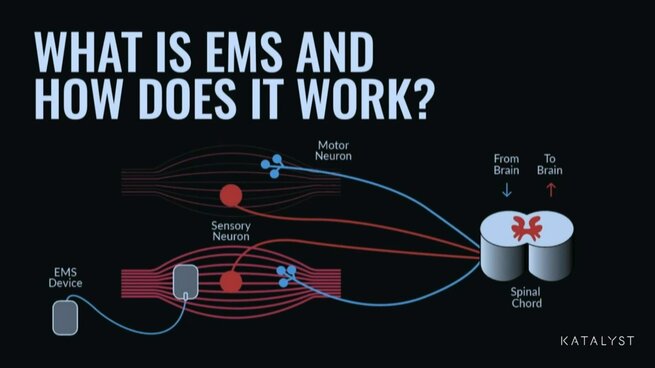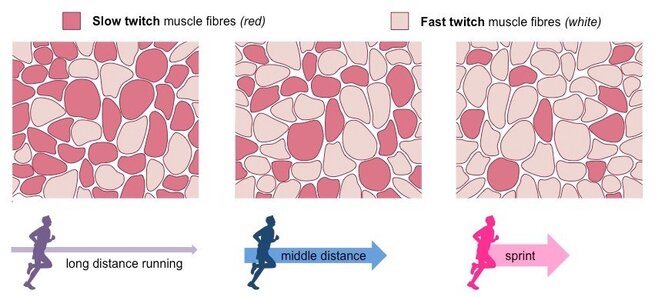What Is EMS Training and Its Benefits?
Discover the benefits, applications, and effectiveness of electro muscle stimulation training.

In recent years, fitness enthusiasts have been embracing innovative workout techniques, seeking efficient ways to achieve maximum results. One such technique that has gained popularity is electro muscle stimulation exercise, also known as EMS exercise. This groundbreaking method delivers electrical impulses to muscles, stimulating contractions and enhancing muscle development. In this article, we will dive into the world of EMS exercise and uncover its benefits, applications, and effectiveness.
What is EMS training?
Electro muscle stimulation (EMS) training is an exercise program that involves the use of an EMS device, such as the Katalyst Suit, that generates electrical impulses to stimulate muscle contractions. These impulses are delivered through electrodes attached to key muscle groups such as biceps, abdominals, quadriceps, and many more, resulting in muscle fiber activation and similar effects to those achieved through traditional exercise. Simply put, EMS exercise mimics the natural process of muscle contraction, amplifying it to achieve more significant gains.

During an EMS session, low-frequency electrical currents travel through the electrodes placed on the skin's surface, reaching deep muscle tissues. These impulses stimulate the motor neurons, causing muscle contractions. The intensity and frequency of the electrical pulses can be controlled for fast-twitch or slow-twitch muscle fibers, allowing personalized training according to the user's fitness level and preferences.

There are two different types of skeletal muscle fibers used to facilitate movement, slow twitch and fast twitch. Learn the differences between them below.
Slow Twitch Fibers
- Used for muscular endurance. They contract slowly but do not fatigue easily.
- Use oxygen for aerobic respiration and have a large amount of mitochondria and many blood vessels.
- Typically red in color due to the dense supply of capillaries.
- Prevalent in endurance athletes, such as marathon runners.
Fast Twitch Fibers
- Used for muscular strength. They contract rapidly but fatigue easily.
- Respire anaerobically and consequently possess fewer mitochondria and blood vessels.
- Typically lighter in color (white).
- Prevalent in strength athletes, such as sprinters.
What are the benefits of EMS training?
EMS technology provides users with several key advantages, such as:
Enhanced efficiency.
EMS exercise engages a higher percentage of muscle fibers compared to traditional workouts, leading to more efficient and intense muscle contractions. This means that in a shorter period, you can achieve the same results or even surpass those achieved through conventional training.
Time-saving.
EMS exercise is known to significantly reduce workout time without compromising the effectiveness of the training. By simultaneously targeting various muscle groups during a single session, EMS can maximize the impact and optimize time management. If you have a busy schedule, EMS exercises enable you to get back to the things you enjoy, such as quality time with family and more time on the golf course.
Improved muscle strength and tone.
EMS exercise can contribute to improved muscle strength, endurance, and tone. By stimulating muscle fibers at a deeper level, it challenges muscles in ways that traditional training alone might not achieve. EMS exercise can support muscle growth and definition in users of various fitness levels.
Promotes injury rehabilitation.
EMS exercise is also beneficial for rehabilitation purposes. It provides a controlled and low-impact environment for individuals recovering from injuries. By selectively targeting specific muscles, EMS exercise can help restore muscle strength and function, aiding in the recovery process.
Added versatility.
One of the greatest advantages of EMS exercise is its versatility. Fitness enthusiasts can incorporate EMS into their existing workout routines, enhancing the benefits and intensifying their training sessions. EMS devices can be used alongside cardio, strength training, or even during yoga or pilates sessions.
A Word From Katalyst
EMS training has found applications in diverse areas such as fitness and sports training, rehabilitation, and muscle recovery. Athletes looking to improve performance, individuals seeking an efficient workout routine, and even people with limited mobility are among those who can benefit from EMS exercise. So, whether you're an athlete aiming to boost performance, a fitness enthusiast searching for a time-efficient workout, or someone recovering from an injury, EMS exercise provides an innovative and versatile option.



